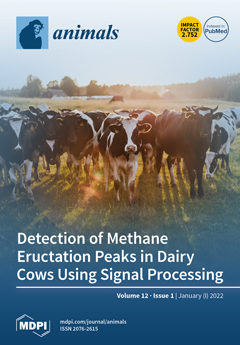This study aimed to evaluate the effect of the incorporation of untreated grape stalks (U
GS) and fungi-treated grape stalks (
Lentinula edodes, T
GS) in rabbits’ diets. The control group was fed with a control diet without grape stalks (C), two experimental groups were fed on diets with 5% and 10% incorporation of U
GS (5U
GS and 10U
GS), and two with 5% and 10% incorporation of T
GS (5T
GS and 10T
GS). Rabbits fed with T
GS diets showed higher daily weight gain (
p = 0.034), feed conversion rate (
p = 0.002), carcass weight (
p = 0.038), and reference carcass weight (
p = 0.03) when compared to the control diet. Moreover, animals fed with T
GS diets showed an increase in the caecum (
p = 0.015) and small intestine (
p = 0.021) lengths and in the total volatile fatty acid content (
p = 0.005) compared to animals fed U
GS diets. Blood triglyceride levels were lower in animals fed with T
GS diets compared to U
GS (
p = 0.005) and C (
p ≤ 0.001) diets (12% and 19% lower, respectively), and a trend to lower cholesterol levels was observed (
p = 0.071). Meat from rabbits fed with T
GS diets had higher levels of linoleic acid, γ-linolenic, ∑ω-6, ∑PUFA, and ∑PUFA/∑SFA ratio compared to rabbits fed with the C diet. Results indicated that grape stalks (U
GS and T
GS) could be effectively used as an alternative raw material in rabbits’ diets without compromising animal performance.
Full article






